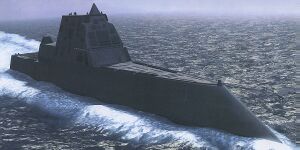Myeongnyang-class cruiser
 KHMS Jinju
| |
| Class overview | |
|---|---|
| Builders: | Hanwha Ocean Co., Ltd. |
| Operators: | Royal Joseon Navy |
| Preceded by: | Salsu-class |
| Built: | 2015-2031 |
| In commission: | 2017-Present |
| Planned: | 12 |
| Completed: | 10 |
| Cancelled: | 2 |
| Active: | 10 |
| General characteristics | |
| Type: | Heavy guided-missile cruiser |
| Displacement: | 28,040 tons full load |
| Length: | 251 m (823 ft 6 in) |
| Beam: | 27.8 m (91 ft 2 in) |
| Draft: | 8.12 m (26 ft 8 in) |
| Propulsion: |
|
| Speed: | exceeds 32 knots (59 km/h; 37 mph) |
| Range: |
|
| Endurance: | Depends on supply situation |
| Complement: | 360 |
| Sensors and processing systems: | |
| Electronic warfare & decoys: | LIG Nex1 SLQ-200K Sonata electronic warfare suite |
| Armament: |
|
| Armor: | Confidential |
| Aircraft carried: |
|
| Aviation facilities: | Hangar and helipad |
The Myeongnyang-class cruiser is a cruiser operated by Royal Joseon Navy. It was planned for 12 ships, and it started to be built in 2018, so a total of 10 ships have been built and are currently active.
The Myeongnyang-class cruiser was designed to conduct naval operations, either alone or in the formation of small maneuver groups. It is also specialized in launching large-scale missile strikes against enemy fleets or ground military installations. Although the practicality of the ship has been questioned due to its role overlapping with that of aircraft carriers, the high firepower of a single ship of the Myeongnyang-class and the stealth design that dramatically reduces its RCS justify its high tactical and strategic importance.
History
When the Svetvostok Navy launched the Lim Se-Kyung class cruiser in the early 2000s, the Royal Joseon Navy began a naval modernization project to come up with countermeasures. This is because, except for aircraft carriers, no combat ships had stronger firepower than the Lim Se-Kyung class in the Royal Joseon Navy at the time. While the Salsu-class guided-missile cruiser contributed to maintaining the gap in the naval power of the two countries and expanding the air defense capabilities of the Joseon Navy, the powerful anti-ship firepower of the Lim Se-Kyung class still brought many concerns to the Joseon Navy.
The Joseon Navy has begun the development of new ships that have strong anti-ship and anti-aircraft firepower while also having sufficient deterrence against other countries' navies as well as Svetvostok. For the design of strong and innovative ships, not only the navy but also the Agency for Defense Development(ADD) was involved in the design of the ships. At the time, tensions between the two countries were high due to the Battle of the Sari Sea between Joseon and Svetvostok, which resulted in the budget for the new cruiser being passed by a landslide within the National Assembly.
12 new cruisers were originally planned, but the budget for new cruisers was cut to 10 after the project took more time than expected and the Navy launched a new aircraft carrier project. The first ship of the Myeongnyang-class was launched in 2015 and deployed to the Navy in 2017.
Design
Stealth
According to the Royal Joseon Navy, despite being larger than an Sejong the Great-class destroyer, the radar cross-section (RCS) is more akin to that of a fishing boat. The tumblehome hull and composite deckhouse reduce radar return. Overall, the destroyer's angular build makes it 50 times harder to spot on radar than an ordinary destroyer.
The acoustic signature is comparable to that of the Ahn Yongbok-class submarines. Water sleeting along the sides and passive cool air induction in the mack reduces infrared signature.
Radar
The Myeongnyang-class is equipped with a four-sided fixed AESA radar. This radar has functionality similar to those mounted on the Salsu-class or Sejong the Great-class, but consumes 10 percent less power. Also, Myeongnyang-class's radar can track 900 targets simultaneously and engage with 25 of them simultaneously. This is better performance than Salsu-class and Sejong the Great-class.
Myeongnyang-class's radar is available as X-Band and S-Band, allowing more accurate and clearer identification of targets with low RCS.
Armament
The Myeongnyang-class has Mk.41 VLS equipped with a total of 64 cells and Mk.57 PVLS equipped with a total of 44 cells. Mk.41 VLS can carry up to 64 standard missiles such as SM-2, SM-3, SM-6, and NGAM. Mk.57 PVLS can carry a larger missile or four standard missiles in one cell.
One 155 mm naval gun mounted on the rear of the ship functions as the only multi-purpose deck gun of the Myeongnyang-class. The 155 mm naval gun is mounted on a stealth-shaped turret and uses the Army's standard 155 mm shells. This is for the efficiency of military supplies, and Myeongnyang-class uses 155 mm long-range guided artillery shells of the Army with a range of over 150 km as ammunition.
All four Phalanx CIWS mounted on the Myeongnyang-class use stealth-shaped turret coats to reduce RCS.